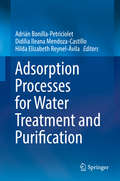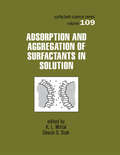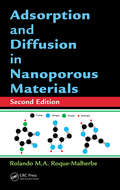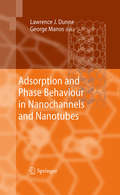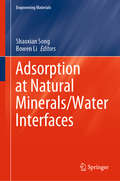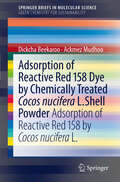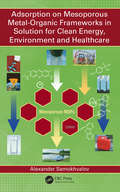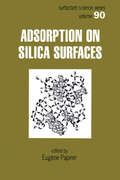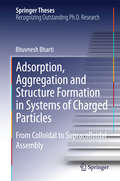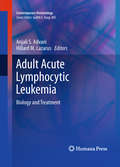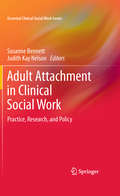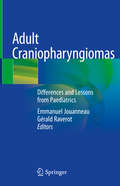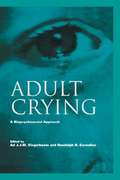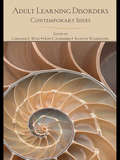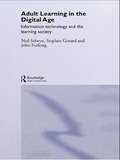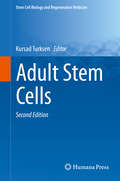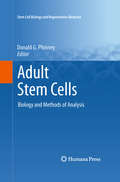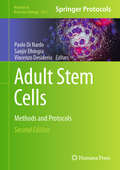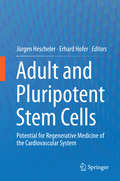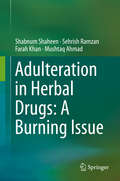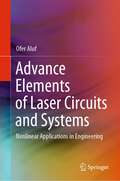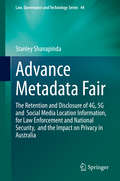- Table View
- List View
Adsorption Processes for Water Treatment and Purification
by Adrián Bonilla-Petriciolet Didilia Ileana Mendoza-Castillo Hilda Elizabeth Reynel-ÁvilaThis book provides researchers and graduate students with an overview of the latest developments in and applications of adsorption processes for water treatment and purification. In particular, it covers current topics in connection with the modeling and design of adsorption processes, and the synthesis and application of cost-effective adsorbents for the removal of relevant aquatic pollutants. The book describes recent advances and alternatives to improve the performance and efficacy of this water purification technique. In addition, selected chapters are devoted to discussing the reliable modeling and analysis of adsorption data, which are relevant for real-life applications to industrial effluents and groundwater.
Adsorption and Aggregation of Surfactants in Solution
by K. L. Mittal; Dinesh 0. ShahOffering the latest research and developments in the understanding of surfactant behavior in solutions, this reference investigates the role and dynamics of surfactants and their solution properties in the formulation of paints, printing inks, paper coatings, pharmaceuticals, personal care products, cosmetics, liquid detergents, and lubricants. Exploring the science behind techniques from oil recovery to drug delivery, the book covers surfactant stabilized particles; solid particles at liquid interfaces; nanocapsules; aggregation behavior of surfactants; micellar catalysis; vesicles and liposomes; the clouding phenomena; viscoelasticity of micellar solutions; and more.
Adsorption and Diffusion in Nanoporous Materials
by Rolando Roque-MalherbeOffering a materials science point of view, the author covers the theory and practice of adsorption and diffusion applied to gases in microporous crystalline, mesoporous ordered, and micro/mesoporous amorphous materials. Examples used include microporous and mesoporous molecular sieves, amorphous silica, and alumina and active carbons, akaganeites, prussian blue analogues, metal organic frameworks and covalent organic frameworks. The use of single component adsorption, diffusion in the characterization of the adsorbent surface, pore volume, pore size distribution, and the study of the parameters characterizing single component transport processes in porous materials are detailed.
Adsorption and Phase Behaviour in Nanochannels and Nanotubes
by Lawrence J. Dunne George ManosChannels of nanotubular dimensions exist in a variety of materials (examples are carbon nanotubes and the nanotubular channels of zeolites and zeotypes) and show promise for numerous applications due to their unique properties. One of their most important properties is their capacity to adsorb molecules and these may exist in a variety of phases. "Adsorption and Phase Behaviour in Nanochannels and Nanotubes" provides an excellent review of recent and current work on adsorption on nanometerials. It is an impressive collection of papers dealing with the adsorption and phase behaviour in nanoporous materials from both experimental and theoretical perspectives. "Adsorption and Phase Behaviour in Nanochannels and Nanotubes" focuses on carbon nanotubes as well as zeolites and related materials.
Adsorption and Transport at the Nanoscale
by Nick QuirkeNanoporous materials are used widely in industry as adsorbents, particularly for applications where selective adsorption of one fluid component from a mixture is important. Nanoscale structures are of increasing interest for micro- and nanofluidic devices. Computational methods have an important role to play in characterizing, understanding, and de
Adsorption at Natural Minerals/Water Interfaces (Engineering Materials)
by Bowen Li Shaoxian SongThis book introduces the latest research regarding the adsorption of heavy metals, toxic ions, and organic compounds at the interfaces of water/minerals, such as mineralogical characterizations, surface chemistry, and modification of natural minerals as adsorbents, as well as the adsorption of cations, anions, and organic compounds in water. Presenting findings by the authors and their co-workers, the book helps readers grasp the principals and benefits of using minerals for water treatment, as well as the advanced technologies in the area developed over last 30 years, especially the last 10 years.
Adsorption of Reactive Red 158 Dye by Chemically Treated Cocos Nucifera L. Shell Powder: Adsorption of Reactive Red 158 by Cocos Nucifera L. (SpringerBriefs in Molecular Science)
by Ackmez Mudhoo Dickcha BeekarooThe effective removal of dyes from aqueous waste is an important issue for many industrialized countries. The traditional treatment methods used to remove dyes from wastewater have certain disadvantages such as incomplete dye removal, high reagent and energy requirements, and the generation of toxic sludge or other waste products that require disposal. The search for alternative and innovative treatment techniques has focused attention on the use of biological materials for dye removal and recovery technologies. This brief summarizes the latest developments in this important field.
Adsorption on Mesoporous Metal-Organic Frameworks in Solution for Clean Energy, Environment and Healthcare
by Alexander SamokhvalovAdsorption and desorption in solution play significant roles in separations, detoxification of waste streams, in purification, chromatography, heterogeneous catalysis, metabolism of medicinal drugs, and beyond. Metal-Organic Frameworks (MOFs) are well-ordered 3-dimensional hybrid organic-inorganic polymers which contain metal cations and the structure-building organic "linker" units. Mesoporous MOFs with pore sizes 2-50 nm are particularly suitable for adsorption and adsorption-based separations of large molecules of organic and bio-organic compounds. Thousands of organic compounds and, in particular, aromatic and heterocyclic compounds are widely used as feedstock for industrial chemical synthesis, as fine chemicals, major components of liquid fossil fuels, dyestuffs, industrial solvents, agricultural chemicals, medicinal drugs, pharmaceuticals and personal care products (PPCPs), and active pharmaceutical ingredients (APIs). There is a strong interest towards synthesis, characterization and studies of both known and newly synthesized mesoporous MOFs for adsorption in solution to achieve the high adsorption capacity, selectivity, and the possibility of multiple regeneration of "spent" sorbent. This book covers experimental fundamental research on using mesoporous MOFs in emerging applications of major industrial, environmental and academic importance, especially purification of water and liquid fossil fuels and in advanced biomedical technologies.
Adsorption on Silica Surfaces (Surfactant Science)
by Eugene Papirer"Progresses from theoretical issues to applications. Contains a historical overview, in-depth considerations of various scenarios of silica adsorption, and results from the latest research. Invaluable for broad coverage of the expanding field of silica research."
Adsorption, Aggregation and Structure Formation in Systems of Charged Particles: From Colloidal to Supracolloidal Assembly (Springer Theses)
by Bhuvnesh BhartiThis thesis presents studies on the interaction of soft materials like surfactants and proteins with hard silica nanomaterials. Due to its interdisciplinary nature it combines concepts from the fields of physical chemistry, nanoscience and materials science, yielding to fundamental insights into the structure-directing forces operating at the nano-scale. It is shown that the morphology of surfactant micellar aggregates adsorbed at the surface of nanoparticles and inside tubular nanopores can be tuned on demand by the co-adsorption of a surface modifier. The interaction of globular proteins with silica nanoparticles is dominated by electrostatic interactions and can be controlled by pH and ionic strength, while the bridging of nanoparticles by adsorbed protein molecules leads to large-scale hybrid aggregates of protein with the nanoparticles. Concepts emerging from the role of electrostatic interactions in the hetero-aggregation of nanoparticles with protein molecules are used for the co-assembly of charged microbeads into linear clusters and chains of controllable length.
Adult Acute Lymphocytic Leukemia: Biology and Treatment (Contemporary Hematology)
by Hillard M. Lazarus Anjali S. AdvaniThe current explosion of new areas of controversy in the treatment of acute lymphocytic leukemia in adults and young adults makes this comprehensive book a much needed reference for hematologists and oncologists. This book assembles leading authorities from around the globe to cover the full spectrum of ALL subtypes and their treatments. Specific topics of discussion include indications for allogeneic bone marrow transplant in first complete remission, the role of minimal residual disease in making treatment decisions, the treatment of young adults, and the treatment of Philadelphia chromosome positive ALL with the advent of the tyrosine kinase inhibitors. This is the first book to focus exclusively on the adult ALL patient. It provides a complete overview of diagnosis, molecular pathogenesis, evaluation, and treatment for this important patient population.
Adult Attachment in Clinical Social Work: Practice, Research, and Policy (Essential Clinical Social Work Series)
by Judith Kay Nelson Susanne BennettThe applicability of attachment theory and research to social work and social policy relating to infants and children is well-established. Yet, its usefulness for enhancing the understanding of adults and their needs, both individually and as a group, has been less featured in the attachment literature. Adult Attachment in Clinical Social Work Practice is a wide-ranging look at attachment theory and research, its application to adults, and its natural fit with the social work profession. This edited volume covers the applicability of adult attachment theory to the clinical social work profession's various domains that include human behavior, practice, policy, research, and social work education. It addresses the broad spectrum of clinical social work, including practice in a variety of public and private settings and with a number of diverse populations, including racial-ethnic groups, gays and lesbians, trauma survivors, and child welfare parents. The book highlights the underemphasized contribution of the social work profession to the development of attachment theory and research.
Adult Continuing Education and High School Course Catalog
by Hadley Institute for the Blind Visually ImpairedAdult Continuing Education and High School Course Catalog 2016-2017. Catalog of current distance education courses for the blind or visually impaired. Various media for the courses is available including; Braille, CD, Digital Talking Books, Large Print, Online and more. Not all courses are available in all formats.
Adult Craniopharyngiomas: Differences and Lessons from Paediatrics
by Emmanuel Jouanneau Gérald RaverotThis volume focuses on adult craniopharyngiomas, offering various perspectives. The first part of the book provides an up-to-date overview of the pathogenesis and management of adult craniopharyngiomas, helping readers understand the pathogenesis and molecular pathways. It highlights the importance of animal models for addressing molecular keys and for developing targeted therapies. The second part deals with clinical management, detailing the latest results in the era of endoscopic surgery, including the major contribution of the extended nasal endoscopic approaches for suprasellar and retrochiasmatic tumors. The book also discusses the key aspects of these tumors and how to manage them. The last part of the book addresses the future therapies and recurrences after surgery and radiotherapy. This volume is of interest to neurosurgeons, endocrinologists, paediatricians, radiologists and oncologists.
Adult Crying: A Biopsychosocial Approach
by Ad J.J.M. Vingerhoets Randolph R. CorneliusCrying is a typical human expression of emotion. Surprisingly, until now little scientific attention has been devoted to this phenomenon. Many textbooks on emotion fail to pay attention to it, and in scientific journals there are hardly any contributions focusing on this behavior. In contrast, there is much interest from the lay public, allowing pseudo-scientists to formulate theories that have little or no scientific basis. Is there any evidence in support of statements that crying is healthy or that not crying may result in toxification? How do people react to the crying of others? Is crying important for the diagnosis of depression, and if so, how? This book aims to fill this gap in scientific literature. Crying is discussed from several perspectives and specific attention is given to methodological issues and assessment. Each chapter provides a review and a summary of the relevant scientific literature.
Adult Learning Disorders: Contemporary Issues
by Lorraine E. WolfRecent advances in neuroimaging and genetics technologies have enhanced our understanding of neurodevelopmental disorders in adults. The authors in this volume not only discuss such advances as they apply to adults with learning disorders, but also address their translation into clinical practice. One cluster of chapters addresses developmental concerns as children and adolescents with learning disorders approach young adulthood. Experts discuss dyslexia, language-based and writing disorders, perhaps the most widely studied group of learning disorders, from the point of view of neuroimaging and genetic underpinnings. Chapters on the neuroscience of nonverbal, math and executive function disorders are also included. Clinically-oriented chapters with case studies, recommendations for accommodation, and considerations for evaluation follow. Study of specialized populations - such as late high school students, college, medical and law students - further demonstrate how our expanded knowledge base may be applicable to clinical practice. The heterogeneity of adults with learning disorders, the complexity of their clinical presentation and co-existing disorders are addressed from both a scientific and clinical point of view demonstrating how empirical research and clinical practice inform each other. This volume will enhance the practice of clinicians and educators working with adults with neurodevelopmental disorders, as well as providing essential current information for researchers of adults with learning disorders.
Adult Learning in the Digital Age: Information Technology and the Learning Society
by John Furlong Stephen Gorard Neil SelwynThis engaging book sheds light on the ways in which adults in the twenty-first century interact with technology in different learning environments. Based on one of the first large-scale academic research projects in this area, the authors present their findings and offer practical recommendations for the use of new technology in a learning society. They invite debate on: why ICTs are believed to be capable of affecting positive change in adult learning the drawbacks and limits of ICT in adult education what makes a lifelong learner the wider social, economic, cultural and political realities of the information age and the learning society. Adult Learning addresses key questions and provides a sound empirical foundation to the existing debate, highlighting the complex realities of the learning society and e-learning rhetoric. It tells the story of those who are excluded from the learning society, and offers a set of strong recommendations for practitioners, policy-makers, and politicians, as well as researchers and students.
Adult Stem Cells (Stem Cell Biology and Regenerative Medicine)
by Kursad TurksenAdult Stem Cells, second edition, takes a critical look at issues concerning the developmental or differentiation potential for a variety of tissue types and for specific adult stem cell types. Since the first edition appeared a decade ago, our understanding of adult stem cells, and more specifically tissue-specific adult stem cells, has advanced tremendously. And an increased interest in regenerative medicine and potential stem cell applications has driven a quest for better understanding of stem cell biology. In turn, this has spawned much activity on generation and utilization of more and better reagents to identify and isolate stem cells and stem cell-like subpopulations, and on assays elucidating their developmental or differentiation potential and functional integration with host tissues and organs. In this fully updated new edition, chapters cover topics ranging from signaling pathways maintaining stemness in hematopoietic cells to regeneration after injury and endocrine mechanisms underlying the stem cell theory of aging. Other chapters cover stem cells by organ or system including pituitary, cardiac, epithelial, teeth, lung, ovary, prostate, liver, and many more. Importantly, the authors of the chapters have not only summarized their successes, but have also summarized some of the difficulties that each particular field is still facing with respect to maximizing the utility of stem cells in clinical settings. Collectively, they impart both the excitement and challenges facing stem cell utilization for repair and regeneration making this book essential reading for those involved in stem cell research as well as those involved in clinical assays.
Adult Stem Cells: Biology and Methods of Analysis (Stem Cell Biology and Regenerative Medicine)
by Donald G. PhinneyThis is comprehensive overview of a vital area of scientific enquiry, which covers a broad spectrum of issues. With contributions from some of the key researchers in the field, Adult Stem Cells: Biology and Methods of Analysis offers readers a historical perspective as well as unique insights into cutting-edge thoughts. The volume contextualizes the recent discovery of stem/progenitor cell populations resident in many adult tissues and organs. It confronts the complexities scientists face in trying to validate these cells, while it also describes and critically evaluates the methods currently used to assess stem cell self-renewal. The chapters also seek to distinguish this process from other aspects of cell survival, such as the regulation of life span, senescence, and immortalization at a molecular level. The monograph begins with a section that examine the basic biology of adult stem cells, including chapters on the emerging role of microRNAs in regulating their fate and the molecular mechanisms that govern their self-renewal, the book moves on to analyze the varying methodologies employed in characterizing these elusive elements of our genetic make-up. The second section details in-vivo lineage tracing of tissue-specific stem cells, explores the neural stem cell paradigm, and considers the function of ABC transporters and aldehyde dehydrogenase in adult stem-cell biology. The final section shifts the focus to the life-span regulation and immortalization and features a chapter on the cancer stem cell paradigm. This is an authoritative volume on one of the frontiers of genetic research, and will serve as a valuable resource, not just for established scientists but also for those now entering the field of stem cell biology.
Adult Stem Cells: Methods and Protocols (Methods in Molecular Biology #2835)
by Paolo Di Nardo Sanjiv Dhingra Vincenzo DesiderioThis second edition volume expands on the previous edition with updated chapters covering a broader range of tissues and techniques pertaining to stem cell technologies. The chapters also cover topics such as the generation of iPSC-derived cells unique to the individual human genome addressing the possibility of more personalized clinical applications to an individual with a specific degenerative disease; and the use of nanoparticles such as 3D scaffolds and biomaterials as a means of improving stem cell viability after transplantation in the host tissue. Written in the highly successful Methods in Molecular Biology series format, chapters include introductions to their respective topics, lists of the necessary materials and reagents, step-by-step, readily reproducible laboratory protocols, and tips on troubleshooting and avoiding known pitfalls. Cutting-edge and authoritative, Adult Stem Cells: Methods and Protocols, Second Edition introduces insights into personalized medicine in stem cell therapies, and will spark new and innovative procedures relevant to stem cell therapy and tissue engineering.
Adult and Embryonic Stem Cells (Stem Cell Biology and Regenerative Medicine)
by Kursad TurksenThis volume will cover a series of reviews on stem cells including adult and embryonic stem cells. Speakers were invited to present these talks during the Stem Cell Symposia in fall of 2010, in Samsun, Turkey. Unique aspect of this volume is that it brings a multidisciplinary aspect of stem cells extracted from a symposium.
Adult and Pluripotent Stem Cells: Potential for Regenerative Medicine of the Cardiovascular System
by Jürgen Hescheler Erhard HoferThere is hardly an area of research developing so quickly and raising so many promises as stem cell research. Adult, embryonic and recently available induced pluripotent stem cells not only foster our understanding of differentiation of endo-, ecto- and mesodermal lineages to all organs of the body, but foremost nourish the hope that cells grown in culture can be used for regeneration of diseased organs such as the heart damaged by myocardial infarction. This book focuses on perspectives of stem cells for regenerative therapy of cardiovascular diseases. Based on the EC consortium INELPY, it reviews the field and disseminates major outcomes of this project. Thus it introduces the reader to this fascinating area of research and incorporates very recent findings interesting to the expert, spanning the field from bench to bedside. The compilation of contributions is unique as there is yet no similar comprehensive overview combining stem cell research with preclinical and clinical evaluation as well as engineering of tissue patches for transplantation. As such it will be an invaluable source of information for all researchers in the stem cell and tissue regeneration field including bioengineers as well as for all clinicians interested in regenerative therapies, especially for ischemic cardiomyopathies.
Adulteration in Herbal Drugs: A Burning Issue
by Mushtaq Ahmad Shabnum Shaheen Sehrish Ramzan Farah KhanSubstitution and adulteration in traded herbal raw material are common practice in the herbal industry due to the extinction of required species, deforestation and incorrect taxonomical identification. Herbalists have adopted methods to create high quality adulteration which cannot be detected without performing microscopic examination or chemical analysis. It is difficult to establish specific quality control standards due to the complex nature and innate unpredictability of the chemical constituents of medicinal herbs.The main parameters for measurement and adulteration prevention in medicinal herbs are morphological and microscopic investigation, chemical profiling and DNA barcoding. The need for highly sensitive and more effective approaches for the authentication of medicinal herbs is necessary in order to promote the acceptance of herbal products. Adulteration In Traditional Medicinal Herbs is aimed at promoting awareness of adulteration in traditional herbal medicines for the worldwide scientific community. Parameters are established for the prevention of adulteration through classical and modern scientific tools. Valuable case studies are presented based on ethno-medicinal surveys performed in many herbal markets in Pakistan. Collections of various samples were obtained from these shops then compared with the original plants collected from field. Various phytochemical, organoleptic and DNA barcoding techniques were used in order to detect adulteration in the marketed herbal samples. This book is the first of its kind and is aimed at helping the scientific community to identify particular medicinal plants which are facing adulteration problems in herbal markets and to estimate the extent of adulteration and substitution in commonly used medicinal herbs.
Advance Elements of Laser Circuits and Systems: Nonlinear Applications in Engineering
by Ofer AlufThis book on Advance Elements of Laser circuits and systems Nonlinearity applications in engineering addresses two separate engineering and scientific areas, and presents advanced analysis methods for Laser circuits and systems that cover a broad range of engineering and scientific applications. The book analyzed Laser circuits and systems as linear and nonlinear dynamical systems and there limit cycles, bifurcation, and limit cycle stability by using nonlinear dynamic theory. Further, it discussed a broad range of bifurcations related to Laser systems and circuits, starting from laser system differential equations and their bifurcations, delay differential equations (DDEs) are a function of time delays, delay dependent parameters, followed by phase plane analysis, limit cycles and their bifurcations, chaos, iterated maps, period doubling. It combines graphical information with analytical analysis to effectively study the local stability of Laser systems models involving delay dependent parameters. Specifically, the stability of a given steady state is determined by the graphs of some functions of which can be expressed explicitly. The Laser circuits and systems are Laser diode circuits, MRI system Laser diode circuitry, Electron-photon exchanges into VCSEL, Ti: Sapphire laser systems, Ion channel and long-wavelength lasers, Solid state lasers, Solid state laser controlled by semiconductor devices, microchip solid-state laser, Q-switched diode-pumped solid-state laser, Nd:YAG, Mid-Infrared and Q-switched microchip lasers, Gas laser systems, copper vapor laser (CVL) circuitry, Dual-wavelength laser systems, Dual-wavelength operation of a Ti:sapphire laser, Diode-pumped Q-switched Nd:YVO4 yellow laser, Asymmetric dual quantum well lasers, Tm3+-doped silica fibre lasers, Terahertz dual-wavelength quantum cascade laser. The Book address also the additional areas, Laser X guiding system, Plasma diagnostics, Laser Beam shaping, Jitter and crosstalk, Plasma mirror systems, and High power Laser/Target diagnostic system optical elements. The book is unique in its emphasis on practical and innovative engineering and scientific applications. All conceptual Laser circuits are innovative and can be broadly implemented in many engineering applications. The dynamics of Laser circuits and systems provides several ways to use them in a variety of applications covering wide areas. This book is aimed at electrical and electronics engineers, students and researchers in physics as well. It is also aimed for research institutes in lasers and plasma physics and gives good comprehensive in laser and plasma systems. In each chapter, the concept is developed from basic assumptions up to the final engineering and scientific outcomes. The scientific background is explained at basic and advance levels and closely integrated with mathematical theory. Many examples are presented in this book and it is also ideal for intermediate level courses at graduate level studies. It is also ideal for engineer who has not had formal instruction in nonlinear dynamics, but who now desires to fill the gap between innovative Laser circuits/systems and advance mathematical analysis methods.
Advance Metadata Fair: The Retention and Disclosure of 4G, 5G and Social Media Location Information, for Law Enforcement and National Security, and the Impact on Privacy in Australia (Law, Governance and Technology Series #44)
by Stanley ShanapindaThis book outlines the legal powers of a major Western nation – Australia – to collect and use location information. Mobile service and social media service providers now have the ability to track, record and store more precise location information. Unlike 4G, 5G mobile communications require that cell towers and antennas be in much closer proximity; as a result, the location data can reveal more personal and sensitive information about individual citizens. Despite this aspect, service providers are required to disclose the data to the authorities, without the need for a judicial warrant. This book was written from the perspective of big location data software analytics, a capability that makes it possible to combine various location data points to create a profile on a given individual’s movements, habits, and political, religious and ideological orientation. In this regard, privacy is poorly protected. The rationale used to justify the powers was enforcing serious crimes – terrorism offences. Location data can now be retained for at least two years and be collected to investigate even minor offences. This can be done without the person being reasonably suspected of a criminal offence – when the individual is simply determined to be a person of interest. This poses legal risks to vulnerable communities. And yet, such investigative techniques are deemed lawful and reasonable. At a time when national security is so broadly defined to include economic issues, which in turn overlap with climate change and environmental protection, these legal powers should be reassessed. The book clarifies the complex rules that every citizen must know in order to have agency. Further, it calls upon authorities to reflect and to self-regulate, by making the conscious decision to surrender some of their powers to review by the independent judiciary. Without the requirement for a judicial warrant or judicial review, the powers are unfairly broad. The book pursues an interdisciplinary approach to assess the functionality of mobile telecommunications in direct relation to law enforcement powers and existing judicial precedents. Further, it offers a unifying techno-legal perspective on a complex issue touching on modern privacy law and communications technologies.
